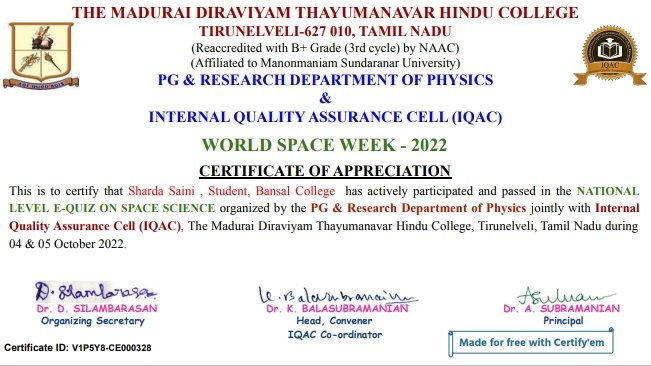
Organizer: PG & Research Department of Physics, The Madurai Diraviyam Thayumanavar Hindu College, Tirunelveli-627010, Tamilnadu, India.
About the Quiz
- Registration is Free
- After successful completion of the Quiz and scoring more than 40%, E-Certificate will be issued through registered email.
By resolution 54/68 of 6 December 1999, the General Assembly proclaimed World Space Week, to celebrate the contributions of space science and technology to the betterment of the human condition. World Space Week is the largest annual space event in the world.
On 4 October 1957, the launch into outer space of the first human-made Earth satellite, Sputnik 1, opened the way for space exploration. A decade later, on 10 October 1967, the Treaty on Principles Governing the activities of states in the exploration and use of outer space, including the Moon and other Celestial bodies entered into force.
The 2022 World Space Week theme, “Space and Sustainability” allows World Space Week to address sustainability from two angles: (1) how space benefits society and contributes to sustainable development on Earth and (2) what are the challenges ahead of us to keep space activities and the space environment safe and sustainable.
Apply Link
Regards,
Dr. A. Subramanian,
Principal
Dr. K. Balasubramanian,
Head & Convener,
PG & Research Department of Physics
Dr. D. Silambarasan,
Organizing Secretary
1) What is the name of the force which keeps the planets in orbit around the sun?*
5 points
Nuclear
Gravity
Electostatics
Lorentz force
2) What is the closest planet to the Sun?*
5 points
Mercury
Saturn
Jupiter
Venus
3) What is the name of the 2nd biggest planet in our solar system?*
5 points
Jupiter
Mercury
Venus
Saturn
4) What is the hottest planet in our solar system?*
5 points
Mars
Venus
Saturn
Mercury
5) About how many light years across is the Milky Way?*
5 points
1,000
10,000
100,000
100
6) The greatest distance of a planet from the sun is called*
5 points
aphelion
perihelion
helix
eccentricity
7) A typical galaxy, such as our Milky Way galaxy, contains how many billion stars?*
5 points
10 billion
40 billion
200 billion
800 billion
8) The study of the origin and evolution of the universe is known as*
5 points
tomography
cystoscopy
cryology
cosmology
9) What percentage of the Sun’s mass has been converted to energy?*
5 points
50%
1%
2%
0.001%
10) According to Kepler’s Laws, all orbits of the planets are*
5 points
ellipses
parabolas
hyperbolas
square
11) Which of the following scientist first hypothesized that the Earth orbited the sun?*
5 points
Alexander the Great
Copernicus
Socrates
Tycho Brahe
12) On which of the following planets would the sun rise in the west?*
5 points
Saturn
Pluto
Mercury
Venus
13) The period from one full moon to the next is*
5 points
30.3 days
30 days
29.5 days
28 days
14) Which of the following words best describes the shape of our galaxy?*
5 points
spherical
elliptical
spiral
barred-spiral
15) Earth is located in which galaxy?*
5 points
The Milky Way Galaxy
Sputnik
Jupiter
Titan
16) What is the name of the first satellite sent into space?*
5 points
Titan
Sputnik
Proba
Juno
17) Presently, what is the farthest planet from the sun?*
5 points
Pluto
Neptune
Uranus
None of the above
18) Which of the following men was the first to make systematic use of a telescope in astronomy?*
5 points
Copernicus
Tycho Brahe
Kepler
Galileo
19) Which one of the following planets has no moons?*
5 points
Mars
Neptune
Venus
Jupiter
20) Have human beings ever set foot on Mars?*
5 points
Yes
No
